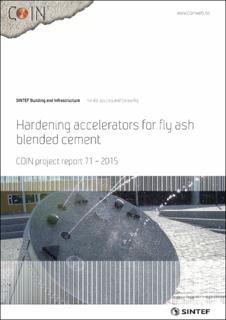Hardening accelerators for fly ash blended cement. FA 1 Environmentally friendly concrete. SP 1.1 Low carbon-footprint binder systems
Research report
Published version
Permanent lenke
https://hdl.handle.net/11250/2826652Utgivelsesdato
2015Metadata
Vis full innførselSamlinger
- COIN Project report [76]
- Publikasjoner fra CRIStin - SINTEF AS [5638]
- Rapporter fra SINTEF Community [775]
- SINTEF Community [2233]
Sammendrag
A former developed hardening accelerator for fly ash blended cement should be replaced with another formulation free from thiocyanate and preferentially with equal or better performance in terms of compressive strength. The 3rd component in the ternary accelerator consisting of 5 parts glycerol, 10 parts diethanol amine and 15 parts sodium thiocyanate (NaSCN) should be replaced since it is believed to cause rust stains on steel moulds.
Based on isothermal calorimetry and compressive strength measurements on mortar, the best candidate in terms of performance is sodium thiosulphate (Na2S2O3) as it also fulfil the requirements to a hardening accelerator at a 0.35% dosage by weight of cement for fly ash blended cement. However, since thiosulphate like thiocyanate is known to form complexes with iron, it is possible that also this component will lead to rust stains on steel as well.
If rust stains still are a problem, it is proposed to change to sodium nitrite (NaNO2) as the 3rd component in the ternary accelerator since this combination barely fulfilled the criteria as hardening accelerator (fell a bit short at 20°C) and is known to be a corrosion inhibitor. If toxicity is a problem, a third alternative is sodium nitrate (NaNO3) that also barely made it but fell short at 20°C.
It is recommended to further work with sodium nitrate and/or sodium nitrite to see if the ternary accelerator could also fulfil the 20°C criterion if the ratio between the components is changed or the dosage relative to cement is increased from the tested 0.35% to for instance 0.50%.
A number of metal silicate hydrate (MeSH) suspensions were tested as accelerators at a dosage of 0.25%, but none performed as well as the ternary accelerators. The most promising MeSH was the one where Me was magnesium. It fulfilled the 5°C criterion of >30% strength increase relative to reference at 2 days with good margin, but fell short for the 20°C criterion of >20% strength increase relative to reference. If the magnesium silicate suspension is to be tested further it is recommended to use sodium silicate as a base rather than potassium silicate, and to perhaps test higher dosages (e.g. 0.5%) relative to cement.
